

 This blog was written by Zach Golden, Director of Client Management at Anova.
This blog was written by Zach Golden, Director of Client Management at Anova.
In a recent Spotio study on B2B buying decisions in 2023, a staggering revelation emerged: “B2B buyers are 57%-70% through buying research before contacting sales”.
This statistic underscores the significant impact of pre-existing biases that most inbound prospects carry when engaging with sales teams. These biases encompass perceptions about your product, your company, competitor offerings, and ultimately which solution they will likely end up choosing.
On the one hand, this can work to a sales teams’ advantage if the prospect has determined their solution to be the early favorite. But even still, there appears to be much out of a salesperson’s control in B2B sales.
So, what can a salesperson do to overcome this and gain back control of the process?
One effective strategy is for salespeople to position themselves as consultants, dedicated to helping prospects understand and address their challenges.
Understanding the Consultative Approach
Anova defines a consultative approach (in the context of B2B sales) as being able to effectively align a solution to meet the needs of a prospect. It is an advanced sales skill, requiring nearly every tool in the sales toolbox, including:
Being consultative goes beyond making recommendations; it involves actively solving the customer’s problems. When done well, this approach can reframe a prospect’s understanding of their own challenges.
Why is a Consultative Approach Important?
Due to the increasing independence of customers in researching solutions, prospects often believe they fully understand their problems. However, a consultative approach can play a pivotal role in reframing the problem and demonstrating how a solution can genuinely address the challenge at hand.
Anova’s data underscores the importance of helping customers better understand their challenges as a key factor in winning B2B sales engagements. In fact, of all the sales metrics Anova tracks across win / loss studies, an effective consultative approach has the highest correlation with winning a B2B sales engagement, more so than product demo quality, ability to make the prospect feel important, and differentiation.
While implementing a consultative approach can be challenging, its impact can be measured and refined through win/loss interviews. These interviews provide valuable feedback from individual prospects, allowing sales teams to continually enhance their consultative approach and gauge its effectiveness over time.
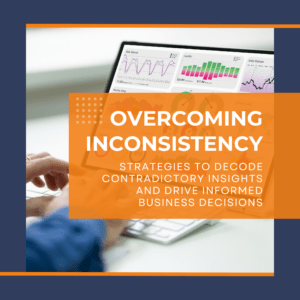 This blog was written by Zach Golden, Director of Client Management at Anova.
This blog was written by Zach Golden, Director of Client Management at Anova.
Stop me if you’ve experienced this before: you’re looking at data to help inform a business decision, but the data seems contradictory.
Perhaps it should be stop me if you haven’t experienced this, because it’s likely you have. Collect enough data points about anything and it’s likely you will find at least two that contradict one another.
Win / loss data is no different. It’s common that companies with win / loss programs have to pause to scratch their head when they start to review findings:
Our solution’s ease of use is being cited as both a strength and a weakness?
Our sales performance is a factor when we win but also when we lose?
Our pricing is competitive but also a reason why we are losing?
At Anova we see these seeming contradictions, what we typically call inconsistencies, every day because of our position as a win / loss partner to our clients. And while sometimes the data can be a head scratcher, our job is to help our clients understand the subtle nuances that cause this inconsistency.
Here are some of the main reasons why you may be seeing inconsistencies in your own data:
High Level Categorizations
When going through feedback from your win / loss interviews or surveys it’s likely you have to bucket or tag the responses into categories that make sense: sales, product functionality, price, etc.
Relying on these broad categorizations is helpful, both to get broad brush strokes of a theme (e.g., 80% of customers like our product functionality) and understand where different areas of your business lie in the eyes of the market (e.g., 80% of customers like our product functionality, compared to only 20% which like our user experience… The market thinks our product can do everything but is overly complex).
However, because of how broad these categories are, it can be confusing when that same category is seen both positively and negatively (e.g., 80% of customers cited our product as a strength, but 75% said it was a weakness… is our product good or bad?!). Part of this is because the category itself has so many specifics to it. For instance, for one client of ours in the supply chain management space, their product is highly praised for things like supply planning and demand planning, but forecasting and the ability to generate custom reports are commonly cited as weaknesses.
Getting to deeper levels of specificity helps our client understand what exactly the market appreciates, and where they need to continue to work.
Segmentations
Sometimes the specificity of feedback is evident, but not who is saying it. That’s where doing some sleuthing becomes necessary. Segmenting the data allows teams to pinpoint if different populations or personas are providing inconsistent feedback about their experience interacting with your company.
For example, in one recent client program we saw large inconsistencies with ratings of its pricing. While discounting was a common practice, the client still thought it should be in the ballpark for the majority of its deals. When we applied a deal size segmentation we uncovered in large enterprise deals the client was largely seen as competitive, but satisfaction with its pricing was much lower in SMB deals. The reason for this was there were many new entrants targeting the SMB market, and were trying to undercut on price.
Our client used this greater granularity of understanding what segment of the market was providing which type of feedback to roll out an updated pricing model for its starter package, commonly utilized in the SMB market, while maintaining its legacy pricing model in its enterprise business.
Team Performance Level
Perhaps the most head-scratching comes from analyzing sales team’s performance metrics. Sales leaders are looking for definite truths about where their team is strong and weak to know where to prioritize investment and training.
However, looking at average scores for the team’s performance in metrics like product demo quality or differentiation don’t always tell the whole story. It can be common to see something rated highly in wins, but poorly in losses. This is especially true when thinking about how the amount of turnover experienced at so many organizations over the last few years has led to great variances in salesperson tenure and product knowledge. Different team members have different skill levels.
Not only do technical skills, tenure, and knowledge all differ amongst your team members, but consistently in and of itself is a hard skill to master.
This is seen all the time in sports: think of a football team that can beat anybody in the league, but when playing in games they are heavily favored, plays down to the inferior level of their opponent only to lose games they shouldn’t. Or the basketball player who can score 30 points one night and 3 the next. What is commonly said on sports talk shows the next day? The team / player needs to be more consistent.
**
Often there are data-driven reasons for inconsistency in your win / loss findings: maybe the categorizations you are using are too broad and you need to be drilling down to a deeper level of specificity. Maybe the different sentiments are coming from different populations of your customer base. Or maybe your team just hasn’t mastered the skill of being consistent.
It’s hard to know which is the right answer, which is why relying on an expert win / loss consultant can help you make sense of your data. Click here to schedule a consultation with one of Anova’s experts.
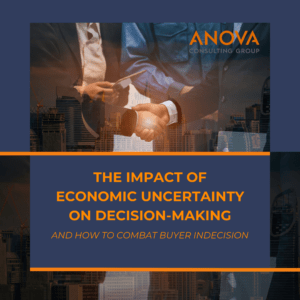 This blog was written by Brian McMahon, Consultant at Anova.
This blog was written by Brian McMahon, Consultant at Anova.
In a year marked by positive economic indicators, including steady stock market gains, a low unemployment rate, and a drop in inflation, one would expect optimism to permeate boardrooms and executive offices. However, a surprising trend emerges: despite these positive signs, a notable pessimism persists among consumers, businesses, and executives regarding the economic outlook. This skepticism is underscored by the findings of the “Measure of CEO Confidence” study, conducted by the Conference Board in late 2023, revealing that 47% of CEOs anticipate a decline in economic conditions over the next six months—a notable increase from 39% in the previous quarter. Moreover, a staggering 72% of CEOs are preparing for a potential U.S. recession within the next 12-18 months.
The Impact of Economic Uncertainty on Decision-Making:
This prevailing economic uncertainty has a profound impact on decision-makers, rendering them more hesitant than ever to make significant purchase decisions. The reluctance to commit is further exacerbated by a fear of purchasing, rooted in what is known as the omission bias—the customer’s desire to avoid taking action that may lead to a loss.
Last year, Matthew Dixon and Ted McKenna of DCM Insights wrote a compelling piece entitled: Stop Losing Sales to Customer Indecision. I would highly recommend it to anyone who is looking to more deeply understand what is driving purchasing decisions (or the lack thereof) nowadays. Anyway, in their research they highlight that customer indecision is responsible for the loss of 40-60% of deals today.
What We’re Seeing Here at Anova:
Anova Consulting Group, having observed these trends across various industries, notes a parallel shift in buyer behavior. To delve deeper into this trend, I took a deeper dive into Anova’s recent work in the retirements and benefits space. What makes the benefits industry an interesting test subject for evaluating indecision is the existence of an already existing solution / provider, combined with the fact that the situations that we examine in this space are those where the sponsor / decision maker made the conscious decision to take this business out to market.
Anova traffics in competitive won and lost situations. So, the deals for which we interview generally entail sales presentations, or long, ongoing, repeated sales conversations. As such, when a plan is brought out to bid, and this process is undergone, most prospects end up moving their plan. However, in 2023, the proportion of plans that are staying with their incumbent provider or putting off / declining to make a decision has seen a sharp increase. In 2021, roughly 20% of losses for our retirement clients made no change in their plan provider, and in 2023, that number YTD is ~37%, almost doubling.
For many of our benefits clients, we ask interviewees how likely they were at the outset of the evaluation to change providers. Generally, when interviewing clients from wins, a considerable portion reflected that they had only been “somewhat likely” to switch at the outset of their evaluation. In other words, they entered somewhat uncertain, but ended up making the decision anyway. We are seeing fewer and fewer of these cases wins that started uncertain but made the decision to switch anyway. In 2021, almost 40% of retirement wins fell into this category and were “somewhat likely” to switch at the outset. In 2023 that number has dropped in half to ~20%, indicating that it is becoming harder and harder to convince executives to make a decision, if their mind was not already made up at the outset.
How to Combat Indecision:
To navigate this environment of heightened buyer indecision, Matthew and Ted prescribed the JOLT method as the strategic approach. The four elements of the JOLT method are:
For us at Anova, the JOLT method, particularly steps 2 and 3, aligns very closely with the recommendations we make to our own clients on how to maximize sales performance. Granted, every sales team is different and will each have different areas of need. However, we have found that a good barometer for identifying a high performing sales team is in how well it succeeds at understanding the unique needs of the customer and proposing a distinct, tailored solution that aligns with those needs. When this is done correctly, the sales team is far more likely to differentiate their offering, sell the value proposition, and win the business.
In 2023, with the heightening indecision that is endemic in the marketplace, demonstrating these skills has become more important than ever.
In their own recent research, Matthew and Ted cited substantial improvements to win rates when sales teams successfully utilized these strategies. They found that when sales teams were able to combine a strong diagnosis of needs with a tailored recommendation that aligns with those needs, win rates rose from 14% to 36%.
Anova’s research is uncovering similar results. Thus far in 2023, we have seen that understanding a client’s unique needs and taking a consultative and prescriptive approach to meeting those needs is vital to winning business. Over the last eight aggregate reports Anova has done across all industries, an average of 93% of respondents in wins rated themselves as “satisfied”* with the ability of the winning sales team to understand their unique needs. For consultative approach, the percentage of satisfied respondents was 89%.
And when you delve specifically into benefits providers, these findings become even clearer. Over the past four reports examining win / loss data for benefits providers, average satisfaction with needs assessment and consultative approach in wins was 96% and 94%, respectively. Furthermore, 41% of respondents in these programs cited the consultative approach taken by their sales team as a key strength, unprompted. For reference, the average percentage of respondents who cited this as a strength across all Anova programs in 2022 was just 23%.
The importance and value of needs assessment and consultative approach is not new. High performing sales teams have always been better in these areas, and proficiency with them has always been correlated to winning. However, due to widespread and increasing buyer indecision, these skills are transforming from “nice-to-haves” to table stakes necessary to win business.
Conclusion:
Executives and buyers are pessimistic about our short-term economic outlook, and it is showing in how they are approaching purchase decisions. Buyer indecision and fear of purchasing is becoming more and more prevalent, and sellers need to revise their approach to combat this. In addition to gauging buyer indecision at the start of the process, sales teams need to accurately assess and display an in-depth understanding of each client’s unique needs during the sale. As economic uncertainty and doubt reign, showcasing that understanding and proposing a distinct and customized solution that takes the burden of choice off the buyer has become vital in overcoming indecision and winning business.
*Note: In Anova methodology, satisfaction is calculated as the percentage of quantitative responses scored 6 or 7 on Anova’s 7-point scale.
 In 2009, Dominos underwent one of the most famous and successful ad campaigns in the 21st century. But it wasn’t just an ad campaign; it was a transformation of their very identity. Dominos looked in the mirror, saw they needed to change, and acted on it. The subsequent years of growth and success were a direct result of this initiative.
In 2009, Dominos underwent one of the most famous and successful ad campaigns in the 21st century. But it wasn’t just an ad campaign; it was a transformation of their very identity. Dominos looked in the mirror, saw they needed to change, and acted on it. The subsequent years of growth and success were a direct result of this initiative.
For those of you who don’t remember, in the years leading up to this change, Dominos was not exactly lauded as a provider of premier cuisine. Dominos was the last resort of last resorts. Kept in business largely by intoxicated college students and desperate insomniacs, Dominos occupied a space in public opinion slightly above uncooked ramen and slightly below a plain, folded-up tortilla. The sauce tasted like ketchup, and the crust tasted like cardboard.
That last sentence was not my own opinion; they are verbatim comments from customers, and those two statements were broadcast across the United States to everyone who would listen. Because instead of burying their heads in the dough, Domino’s did something radical: they admitted they were “sucking.” In what was dubbed as the “We’re Sorry for Sucking” campaign, Dominos found some of the most biting criticism about their product, publicized it, apologized, and promised to act.
This wasn’t your typical PR spin; it was a raw, honest apology. Domino’s aired commercials showcasing their subpar pizzas, invited customers to roast them on social media, and came clean on methods they had been using to make their pizza look more appetizing than it was. It was a gamble, a public flaying, but it was also a masterclass in the power of gathering, and acting on, feedback.
So, what made this campaign so successful? Here are a few key takeaways:
Embrace your flaws: Denial is a recipe for disaster. By acknowledging and accepting its issues, Dominos was able to clearly see what needed to be done and organize a plan of action.
Listen to your customers: They didn’t just hear the complaints; they actively sought them out, creating avenues for customers to voice their frustrations.
Show you’re listening: By showing customers that they were listening to and acting on their feedback, Dominos conveyed that they valued their customers and wanted to meet their needs.
Act on the feedback: Domino’s didn’t just apologize; they used the feedback to overhaul their recipes, improve their service, and invest in technology.
Be transparent and authentic: The campaign wasn’t slick or polished; it was honest and relatable. By being humble and willing to change, Domino’s established trust with its customer base.
The results were nothing short of spectacular. On December 31st, 2009, Domino’s stock price was $6.87. As I am writing this in early 2024, Domino’s stock price is $426.77. That represents an increase of over 6200%. In that same time, Domino’s market share went from 9 – 15%. There are a lot of factors that drive financial performance, so this growth cannot be attributed entirely to the “We’re Sorry for Sucking Campaign.” However, in the time leading up to it, Domino’s was struggling — in 2008 Domino’s same-store sales growth declined for the first time ever, and that decline continued in 2009, along with net income, and customer satisfaction. It is safe to say that that trend was handily reversed, and the “We’re Sorry for Sucking” campaign marked a pivotal moment in Domino’s history.
So, the next time you’re looking to improve your performance, or that of your business, remember Domino’s. Search out feedback and don’t shy away from it. Embrace it. Use it to improve, to grow, and to forge a stronger connection with your customers. Because sometimes, admitting you’re “sucking” can be the first step to soaring.
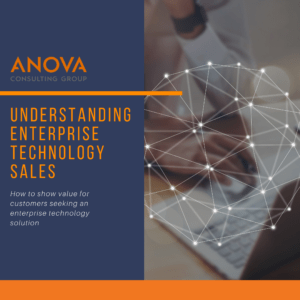 Why do enterprise software sales teams win and lose deals? Traditional thinking would hypothesize that for high-dollar value, complex software platforms, the strength of their solution drives wins while losses are driven by a perception of higher price points and more difficult implementations, especially compared to less robust, cheaper, point solutions. Does the difference between winning and losing truly come down to price and a perception of being easy to work with? If that thinking holds true, how can enterprise software companies win despite being perceived as more expensive and more difficult to implement than their competitors?
Why do enterprise software sales teams win and lose deals? Traditional thinking would hypothesize that for high-dollar value, complex software platforms, the strength of their solution drives wins while losses are driven by a perception of higher price points and more difficult implementations, especially compared to less robust, cheaper, point solutions. Does the difference between winning and losing truly come down to price and a perception of being easy to work with? If that thinking holds true, how can enterprise software companies win despite being perceived as more expensive and more difficult to implement than their competitors?
This report explores how in enterprise software deals, winning in these competitive situations is predicated more on demonstrating value rather than absolute cost or perception of effort involved. In order to fully examine this, Anova analyzed findings from thirteen win / loss programs conducted between 2022 and 2023 focused on complex, high value enterprise software deals. Our goal was to understand what winning sales teams do differently to set their solutions apart and ultimately win more. Company names in this case study have been scrubbed and will be referred to as the Client.
Better Understanding the Price / Value Dynamic
In those thirteen programs, one of the most interesting findings was that when our Client won, in just over half of those winning situations their newly acquired customer was actually more satisfied with a competitor’s price point. Despite being at a pricing disadvantage, the Client was able to win because they proved their solution would drive superior value for the customer. Conversely, when we looked at the inverse loss data, 100% of the time when our Client lost, customers rated themselves as more satisfied with both price point and expected value of the winning solution.
Figure 1 illustrates one specific situation representative of this finding. When this Client won, satisfaction with its value exceeded that of its top competitor (75% versus 50%), even though it fell behind its competitor in terms of satisfaction with price levels (50% versus 100%). In contrast, when the Client lost, the winning vendor outperformed it in both value satisfaction and pricing satisfaction.
Figure 1 Satisfaction with Price Levels and Value in Wins and Losses Between Clients and Competitors

Additionally, in our Clients’ winning situations, an average of just 48% of prospects were satisfied with their expected ease of implementation. Said another way, more than half of newly won customers expected to be dissatisfied with their selected vendor’s implementation process yet recognized that the value of the implemented solution would outweigh the pain of installation.
Driving to Value
It becomes clear that the expectation of high value can outweigh pricing and implementation concerns. So, the question then becomes: how can software sales teams become successful at proving their value to their customers?
Click here to read the full case study.
 Everyone loves a good spy story. But unless you’re at the movies or picking up a book, it’s hard to transport yourself into the world of espionage. That was, until competitive intelligence became a key component in the realm of business.
Everyone loves a good spy story. But unless you’re at the movies or picking up a book, it’s hard to transport yourself into the world of espionage. That was, until competitive intelligence became a key component in the realm of business.
Some corporations go to great lengths to obtain competitive intelligence about rival firms. In a recent article on CNBC, Eamon Javers detailed some practices which he coined “corporate espionage.”
The article centered around one story (really an “operation”) which included undercover employees collecting data on a competitor. The employees collected intelligence by attending a rival’s conference and eavesdropping on key personnel at the bar or hiding out in the bathroom waiting to overhear any conversations. After they identified a key meeting of rival senior directors, the competitive intelligence team snuck into the conference room after the meeting to gather leftover notes and materials.
If this seems like something straight out of a spy thriller, it may be because the company was using ex-CIA operatives who had actually written spy novels to manage their corporate espionage missions. While it is not uncommon for corporations to have competitive intelligence activities, the lengths that some companies go through to collect information on the firms they compete against can be eye-opening.
But it doesn’t always have to read like a Tom Clancy novel. Competitive Intelligence (CI) can be gathered a number of different ways, and CI is a key component of Anova’s research programs. In Win Loss analysis (also mentioned in the article as a CI practice), using a third party to learn how the competition behaved during a sales situation and how they compared to your own sales effort is a major objective of the research. Departed Client analysis similarly aims to understand why your clients left for a competitor. Intermediary Perception studies gather competitive data as advisors, consultants and resellers often times have more holistic market perspectives and can evaluate one offering against a number of firms.
A lot of the best competitive intelligence can come just from talking to who it matters most: your prospects and customers. Using a third-party to get unfiltered feedback and insights about your offering compared to the competitive landscape is critical in today’s sales and service environments. Whether you play the theme song to James Bond while you read the results is entirely up to you.
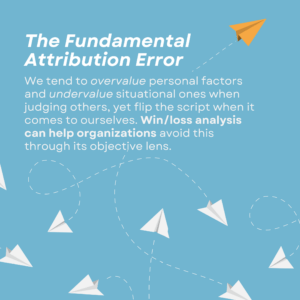 This blog was written by Harriet Peabody, Research Analyst at Anova.
This blog was written by Harriet Peabody, Research Analyst at Anova.
The fundamental attribution error is a cognitive bias that leads people to overestimate the influence of personal factors and underestimate the influence of situational factors on others’ behavior, while doing the opposite when assessing their own behavior. In other words, we attribute our own failures to the situation we were in rather than taking personal accountability due to our self-serving bias, while placing blame on others for their failures.
This bias can have a significant impact on our decision-making, both in our personal and professional lives. For example, if we win a big sale, we may attribute our success to our own superior skills and abilities. But if we lose a sale, we may blame the customer for being difficult or unreasonable. This attribution error prevents us from effectively learning from our losses and improving.
This is where win/loss comes in. Win/loss analysis can help organizations avoid the fundamental attribution error by providing a more objective and systematic way to evaluate performance. With voice of the customer data, organizations can read real feedback as to why they won or lost a deal. Rather than attributing wins to the sales team’s strength and losses to the unique situation they were in, organizations can identify points of strength and areas for improvement directly from the source. By carefully analyzing the factors that contributed to each win and loss, organizations can gain a better understanding of the true drivers of success and failure and can then develop a plan to replicate their successes and improve upon the factors contributing to failures.
To develop this plan, organizations need a more realistic assessment of their strengths and weaknesses. When it comes to strengths, organizations may use wins as confirmation that their team is executing well and should keep doing what they are doing. In reality, there are always areas for improvement, even in wins, and win/loss analysis helps to identify those as well as the strengths that drove the win. Even more helpful is the identification of weaknesses in lost deals. Rather than looking at the situational factors that may have contributed to a loss, a more productive process is to look at what you did have control over and could do better next time. Win/loss analysis is the best way to learn what the customer thought you could have done better, and course correct going forward, thus avoiding the fundamental attribution error.
Here at Anova, not only are we committed to helping our clients avoid the fundamental attribution error through data collection and identification of actional insights from their customers, but we are also committed to avoiding this bias within our own organization. One of our company values is ownership, something we often refer to as “less fingers, more thumbs,” meaning that instead of blaming the situation or others for any difficulty we are having, we take accountability for what we can control and take action to improve the situation. Recognizing that we do have this cognitive bias is the first step, and the next step is operationalizing a plan to counteract it. Choosing to establish a win/loss initiative at your organization is a great plan for avoiding the fundamental attributional error and therefore learning from your losses and achieving more wins.
 Note: This piece is written by Zach Golden, a Consultant for Anova, about his first-hand experience in seeing the importance of giving customers a voice.
Note: This piece is written by Zach Golden, a Consultant for Anova, about his first-hand experience in seeing the importance of giving customers a voice.
A few months ago, I was sitting in a meeting with the Head of Service for one of Anova’s clients, a large retirement services organization with thousands of clients across the country. We were discussing the current state of their customer base including satisfaction and retention.
The Executive was talking about the steps his organization was taking to determine which clients were loyal, referenceable customers, and which ones were at risk of leaving. His response was relatable to many companies. He said, “We do pulse checks of our customers multiple times throughout the year, almost whenever there is an interaction with one of our service reps. We send them an online survey to fill out asking for an NPS® score, and all the answers come back with great responses. But then we lose a bunch of clients at the end of the year and our salespeople want to know why we can’t retain the customers they sold.”
This problem is indicative of a trend that has overtaken the marketplace: the over-simplification of customer satisfaction research.
The Net Promoter Score® is meant to be a relationship metric, not transactional. However, so many organizations get sucked in to trying to quantify the interactions with their customer base. These organizations tend to lose sight of the forest for the trees. Some organizations obsess over each touch point, but fail to understand how the overall relationship with their client is being perceived.
In the case of our retirement services customer, the friendliness of their call center representatives resulted in high NPS® scores because their clients were pleased with the cheerfulness of the service personnel. However, these same customers were dissatisfied with the overall relationship because there was little proactive communication or help offered to them, particularly during tax and reporting season.
Customers need to be heard from. They need a platform to voice their satisfaction and dissatisfaction about all aspects of the relationship. They need someone to listen to them and ask questions about specific pain points. A simple NPS® metric cannot deliver that detail.
In-depth phone conversations serve as a contrarian approach to gathering feedback from today’s overly web-surveyed customers. They allow the person to feel more valued because their feedback is actually being heard, instead of being lumped in with all the other web surveys they receive after every transaction at the supermarket, coffee shop, or car wash. The conversations let customers voice their opinions on a wide range of attributes impacting their entire relationship.
It is estimated that it costs 7 times as much to acquire a new customer than to retain an existing one. At that cost, keeping current clients as satisfied as possible is a necessity for companies looking to improve their bottom line. What is the most effective way at ensuring clients are satisfied? Actually listening to what they have to say.
Net Promoter®, NPS®, NPS Prism®, and the NPS-related emoticons are registered trademarks of Bain & Company, Inc., NICE Systems, Inc., and Fred Reichheld. Net Promoter ScoreSM and Net Promoter SystemSM are service marks of Bain & Company, Inc., NICE Systems, Inc., and Fred Reichheld.”
 If you are in sales, you are most likely goal-oriented and performance-driven. Your ability to win business – to convert leads into closed business situations – becomes your report card. And if you are a successful salesperson (or working to become one), you most likely focus on your new situations and pipeline, constantly working the sale and finding the path to closing that piece of business.
If you are in sales, you are most likely goal-oriented and performance-driven. Your ability to win business – to convert leads into closed business situations – becomes your report card. And if you are a successful salesperson (or working to become one), you most likely focus on your new situations and pipeline, constantly working the sale and finding the path to closing that piece of business.
How would you like to put yourself ahead of the rest?
Win / Loss Analysis is a game changer. No longer are you just looking at a scoreboard – how many deals did you close and how many did you loss? Win / Loss takes you beyond the score and moves into your performance, helping you learn the real reasons that drove a prospect to a certain decision.
This is information you need to know. The most important way to close more business is to learn what your clients and prospects are thinking at every stage of the sales experience. With this intel, you can move ahead of your competition by using real, actionable feedback to improve your performance in the next opportunity.
A Win / Loss program will help you:
In the current competitive market, success goes beyond simply keeping score of wins and losses. Sales professionals aiming to stay ahead of the curve are turning to Win / Loss Analysis for a deeper understanding of their performance. A Win / Loss program not only helps improve messaging and effectiveness but also sheds light on competitors’ successes and identifies drivers for closing new business. This approach encourages continuous improvement across the entire sales process, from initial rapport-building to sealing the deal, empowering sales professionals to enhance their performance and increase their chances of winning business. Consider how elevated your sales activity could be if you were receiving in-depth, post-sales debriefs after each and every decision in your pipeline.
So how can you best use Win / Loss for sales success? Try some of these helpful resources:
From a Good Sales Call to a Great Sales Call
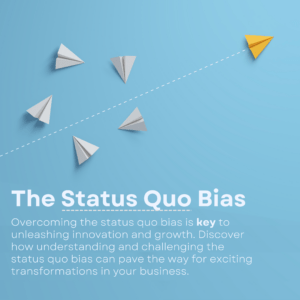 This blog was written by Harriet Peabody, Research Analyst at Anova.
This blog was written by Harriet Peabody, Research Analyst at Anova.
Status quo bias is a cognitive bias that leads people to prefer the current state and resist change. This bias can be seen in many different areas of life, from personal decision-making to organizational decision-making.
In the context of organizations, status quo bias can lead to several problems, including:
A failure to innovate. Organizations that are stuck in the status quo are less likely to develop new products and services, or adopt new ways of doing things, putting them at a competitive disadvantage.
A failure to meet customer needs. Customers’ needs and expectations are constantly changing. Organizations that don’t listen to their customers’ feedback and make changes accordingly are at risk of losing their customers to competitors.
A failure to adapt to change. The business world is constantly changing, and organizations that don’t adapt to change are likely to fall behind their competitors.
Voice of the customer (VOC) feedback is a way to collect and analyze customer feedback to better understand their needs, expectations, and pain points. By listening to VOC feedback, organizations can identify addressable areas that will directly benefit their customers.
VOC feedback can help organizations avoid status quo bias in a number of ways:
It provides a fresh perspective. VOC feedback comes from customers with different perspectives than employees, helping organizations identify areas where they are falling short of customer expectations.
It identifies areas for improvement. VOC feedback helps organizations identify weaknesses and implement improvement plans that address customer needs.
It provides evidence for change. VOC feedback provides crucial evidence to support the need for change, helping overcome potential resistance from employees and other stakeholders.
Anova helps clients avoid status quo bias not only by providing VOC feedback in the form of win/loss, customer satisfaction, and customer churn programs, but also by generating actionable insights from the VOC data. Clients learn directly from the customer what they need to do to stay competitive, coming away with ideas on how they can begin making improvements. Additionally, Anova’s competitive benchmarking data helps clients prioritize areas for improvement by comparing client results to others in their industry. Keeping up on competitor innovation drives organizations to innovate themselves to avoid falling behind.
The Anova value of a growth mindset means that we as a team are ‘content but never complacent.’ Rather than sticking to the status quo and an ‘if it ain’t broke, don’t fix it’ mindset, we push ourselves to continuously improve and better serve our clients. This involves being receptive to feedback as well as pushing ourselves outside of our comfort zone to embrace change. Using VOC data combined with a commitment to being open to change, data driven, and customer centric, Anova aims to ensure our clients are well-positioned to remain competitive and win more deals by virtue of avoiding intrinsic status quo bias.